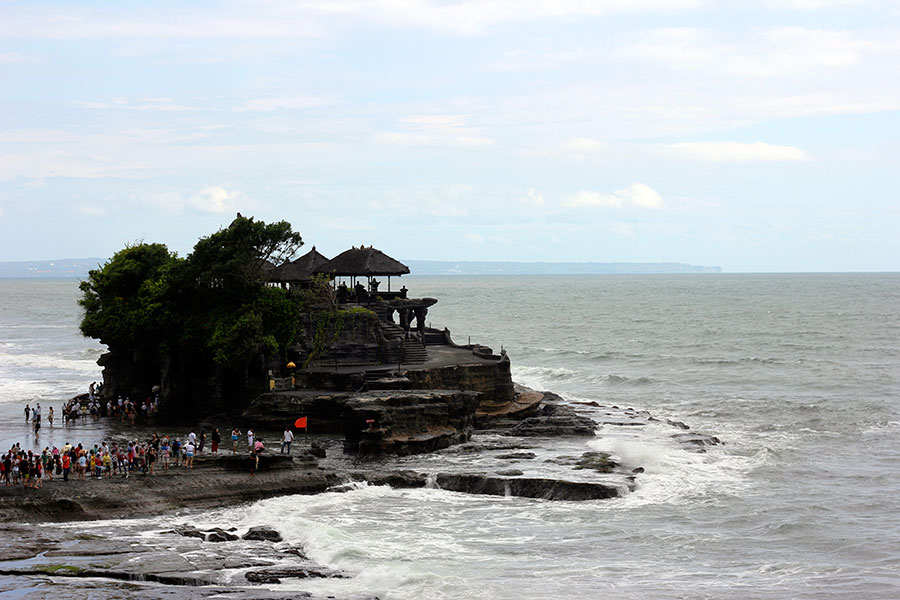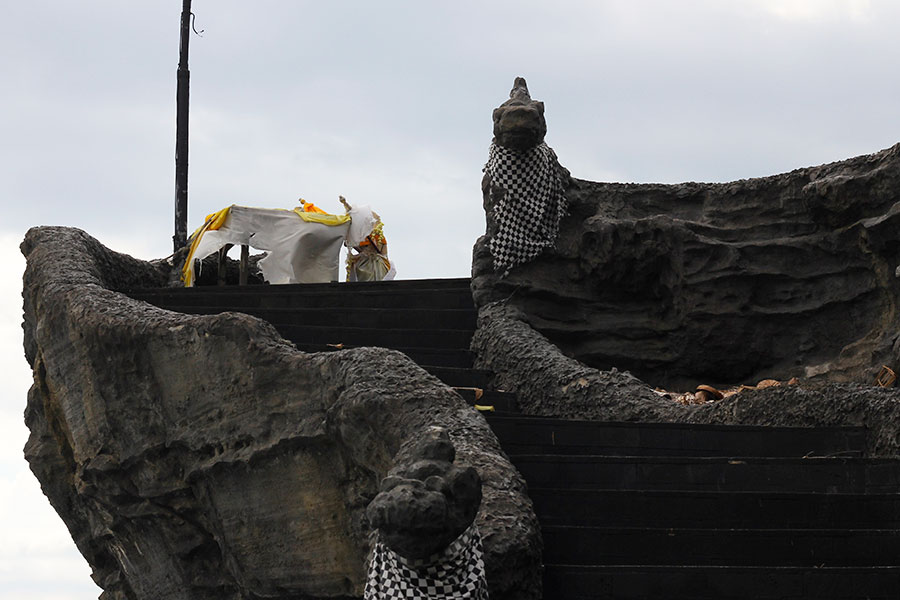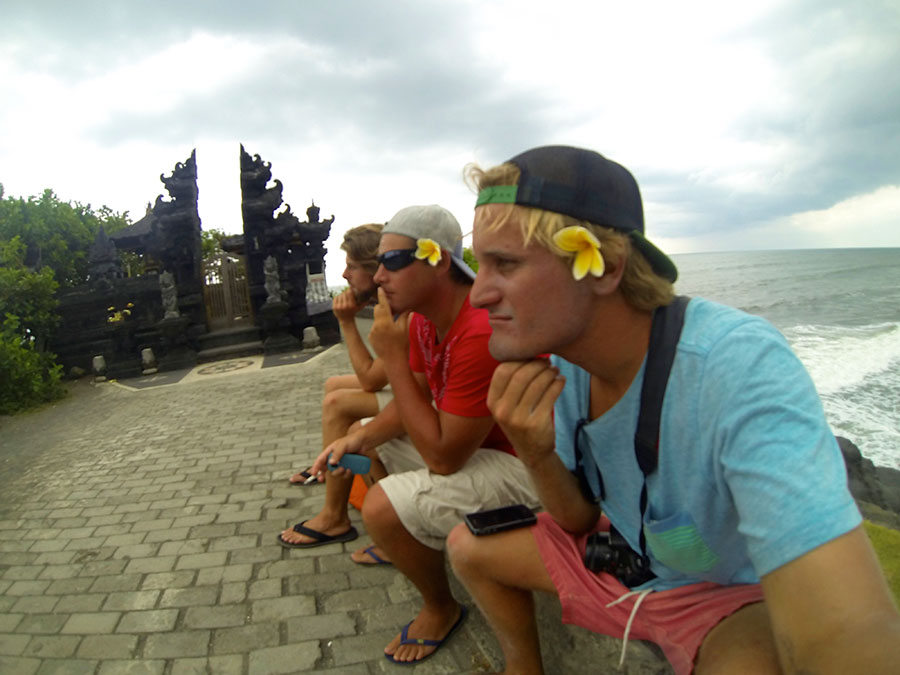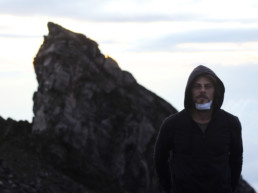There’s a major caveat that comes with being “Bali’s most visited and photographed temple”, Pura Tanah Lot.
Think tour groups. Tour groups everywhere.
You know the ones I’m talking about.
Think scores of matching shirts and caps following around flag-waving guides speaking incomprehensibly into little microphones.
From the moment you enter the parking lot and run headlong into a wall of buses, you get the feeling that this is the kind of place everyone knows about, visits, and they’ve managed to create a special, ready-to-consume experience just for you! It continues after you’ve paid to park and enter the complex as you wind your way through a seemingly endless maze of shops and stalls selling everything from such Bali staples as Bintang singlets and wood carved penises – which are definitely purchased to display proudly in the owner’s home as a sign of virility, and not as a gag gift – to Polo by Ralph Lauren. What’s that over there, you ask? Why yes, it is an ATM! How very convenient.
And just as the cheap trinkets and aggressive vendors and buy me now! mentality and thronged masses begin to really get to you, the sound of waves crashing against rocks and salty sea air flood your senses, and a glittering multi-tiered temple perched on a rock just out to sea comes into view and punches you right in the pupils.
Oh, right. That’s why everybody’s here.

Pura Tanah Lot (Tanah Lot means “land in the sea”), located about 20KM northwest of the travel hub of Denpasar in Tabanan village, has been part of Balinese mythology for centuries. Widely regarded as the most beautiful of Bali’s six cardinal temples, it also stands as one of seven sea temples that form a loose chain along the island’s coast. Traditionally it’s been said that on clear days each of the temples is visible from the next. Supposedly, in high visibility it’s possible to see all the way to Pura Uluwatu on the southwestern coast of the Bukit peninsula, although I had no such luck during my visit.
Legend has it that the site was founded by a roaming 16th century Brahmin priest from the Majapahit Kingdom in Java named Dahyang Niratha. According to the tale, during his travels along Bali’s coastline Niratha saw the rocky outcropping known presently as Tanah Lot and decided to stop there in order to rest and meditate. He was later spotted by some local fishermen, who brought the priest gifts. Niratha decided to spend the night on the little island, and subsequently told the fishermen that they should build a shrine to the gods and goddesses of the sea there because he felt it to be a holy place. Locals believe that small, poisonous black and white sea snakes (along with one very large snake) abound in the waters around the temple, protecting it from evil spirits and intruders. These snakes are said to be Niratha’s sashes, which fell into the sea when he left the sacred spot.

The rock that Pura Tanah Lot sits upon has been shaped and eroded over the years by strong ocean tides; as a result, by 1980 the rock face was crumbling badly and the area had become dangerous. The Japanese stepped in at this point and provided a loan to the Indonesian government to conserve the temple and other significant locations around Bali, so today 1/3 of Pura Tanah Lot’s 3-acre surface is actually disguised artificial rock. This fact, along with the carefully cultivated tourist trap set up all around the temple, has led many to deride the destination as having “all the authenticity of a stage set.” While I’ll stop myself juuuuust a smidgen short of being quite that critical, I will note that Pura Tanah Lot is an excellent place to go if you enjoy the minor celebrity that comes along with being asked by multiple Chinese tourists to pose (with double peace signs, naturally) in their family vacation photos.
The temple itself is accessible only at low tide, when a sandy foot path appears between the shore and the island. Inside Pura Tanah Lot there are two pavilions and two shrines with a 7-tiered meru (pagoda) and a 3-tiered meru. Unfortunately, non-Hindu tourists aren’t allowed inside the temple at any time, so you’ll just have to take my word on it. With that said, for a small donation you can receive a blessing and walk 20 meters on a pathway around the side of the temple for a better view of the ocean.

While the vast majority of visitors are foreign day-trippers, Pura Tanah Lot is extremely important within the realms of Balinese spiritualism and mythology and thus attracts a fair number of Hindus making pilgrimage to honour the gods and goddesses of the ocean. Curiously, you won’t find many young Hindu couples among those coming to pray; popular myth holds that unmarried couples who visit the temple will break up soon afterwards.
The best time to visit is undoubtedly sunset, but be warned: this is also the most popular time. Hoards of tourists that make the morning and early afternoon crowds seem sparse by comparison descend as the sun sinks to get their snaps and can overwhelm.
Pura Tanah Lot is what it is. If you’re looking for untouched beauty and tranquil, undeveloped surroundings, you’ve come to the wrong place – millions of international and domestic tourists make the trip annually. But if you can look past the sunglasses and clifftop restaurants and teems of people, you’ll still find a temple with one hell of a view*.

How To Get To Pura Tanah Lot
It’s possible to reach Pura Tanah Lot from anywhere on Bali. It takes about 45 minutes by car from the southern tourist area of Kuta/Legian/Seminyak, and 30-40 minutes from Ubud. It’s easy enough to sign up with a tour group as part of a half-day trip, but if you’re feeling a tad more adventurous try renting a motorbike and making the journey yourself. The relaxed town of Canggu just north of Seminyak is a great jumping off point for the cruise that will take you about 20-25 minutes. Simply go along the road that follows the coast west of Kerobokan and numerous signs will point the way. Admission is 30,000 IDR (about $2.50 USD) for adults, 15,000 IDR ($1.25) for children and parking will run you 5,000 IDR ($0.40 USD).
Pura Tanah Lot photos courtesy of Kris Wigley
Make your next trip the best one.
Departful is a full service travel agency creating truly exceptional travel experiences that are 100% personalized to you. Wherever you’re going, whatever your interests, we help you plan the perfect trip.
Alex Rathy
Alex is a writer, ESL teacher, baseball enthusiast and Hunter S. Thompson fanatic currently based in Sydney, Australia. He has previously lived in Canada, the U.S., South Korea and China and has traveled extensively throughout Asia. He enjoys hiking, spicy food, dance parties in the jungle, questionable hairdos, Vonnegut novels and has been known to appreciate a good hammock on occasion.




